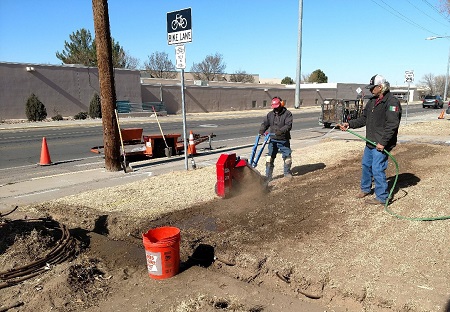 Workers of New Mexico State University's Facilities and Services Department trench holes into the yards of student homes on Espina Street in order to install a subsurface irrigation system to reduce the amount of water being wasted by traditional sprinklers.
Workers of New Mexico State University's Facilities and Services Department trench holes into the yards of student homes on Espina Street in order to install a subsurface irrigation system to reduce the amount of water being wasted by traditional sprinklers.
(Courtesy photo by Bud Jones)WRITER: Melissa R. Rutter, 575-646-4211, mrrutter@nmsu.edu
A New Mexico State University agriculture professor and a grounds manager are teaming up to drastically reduce the amount of water that goes to waste with traditional sprinklers at student housing by installing a subsurface drip irrigation system.
Work began about a month ago for Bud Jones, grounds manager at the Facilities and Services department at NMSU, and his team who have installed the subsurface drip irrigation system at 15 homes at the Sutherlands Village along Espina Street.
"Subsurface irrigation is an application where we come in and install an irrigation system that is under the turf. It waters from the ground up and takes the water to the root system instead of having pop up sprinklers come up above ground and spray over the turf. The system utilizes about 10 percent of the water needed to have an above ground system," Jones said.
Jones was asked by professor and Extension Turfgrass Specialist Bernd Leinauer, who had been focusing his research on efficient irrigation systems, if they could install the subsurface irrigation system. Despite having investigated this system for years and after publishing his findings, Leinauer was still met with hesitation from his fellow academic colleagues who wanted to see real-world demonstrations.
"We approached Bud who was using the oscillating sprinklers on the lawn in front of the houses. Those sprinklers were wasting water so we asked him if we could install our irrigation system. It was the perfect area to put in a real-world demonstration," Leinauer said.
Jones and his team soon got to work on the irrigation system with some equipment help from Leinauer's research team.
"We borrowed a trencher from Dr. Serena and Dr. Leinauer that goes down and makes little trenches that are about four inches wide and four inches deep into the soil. We then lay the irrigation pipes into the trenches, which are about one-foot apart. The drip lines are connected to a main line which is hooked up to the valve and to the water source. It's like putting together a little puzzle," Jones said.
With the irrigation system being set up underground, Leinauer said people have voiced their concerns about roots growing into the tiny holes that release water and could clog up the system.
"One manufacturer puts in a small amount of herbicide into the plastic that surrounds that hole, so roots don't penetrate. But this approach brings the concern of using chemicals and not being environmentally friendly. So, two other companies at about the same time came up with the idea of using copper. A very small amount of copper is toxic and stuns root growth and forces the roots to grow around the pipes," Leinauer said.
A few disadvantages the irrigation system does face is the up-front cost and public acceptance. With subsurface irrigation still being a relatively new concept, moving away from traditional sprinklers is still difficult.
"Depending on the size, we are looking from anywhere from 30 to 50 percent more of a cost than a traditional sprinkler system. And then there's public acceptance, people that work with irrigation are opposed to it because they are still stuck with the old system," Leinauer said. "That is why these projects help, the more publicity we get out of these projects, the more the public will realize that it's a water-saving alternative."
Despite those disadvantages, there are some cost-saving benefits in the long run. Jones, who has been working on the type of irrigation system for about 20 years, believes these advantages outweight the disadvantages.
"If you look at man-hours for repairs it is definitely cheaper. Also, there are cost savings because we are having to pump less water through our irrigation systems and using less electricity for pumping that water," Jones said.
Leinauer's research has taken him all around the state of New Mexico, including Albuquerque where his irrigation system is set up in a local park.
"We work with the City of Albuquerque, and we actually have an entire city park that we cut in half, and one half is irrigated with a subsurface drip system and the other half is on sprinklers. The City of Albuquerque Parks and Rec department pays between 3 and 4 million dollars every year just for water. So, they're under the strict mandate to conserve water and by going out large scale and documenting what happens, we can save 30 percent water for them," Leinauer said.


